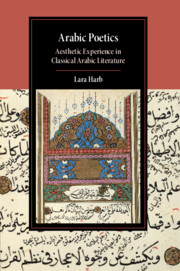Book contents
- Arabic Poetics
- Cambridge Studies in Islamic Civilization
- Arabic Poetics
- Copyright page
- Dedication
- Contents
- Preface
- Acknowledgments
- Note on Dates, Translations, Transliterations, and Names
- Introduction
- 1 Wonder
- 2 Wonder in Aristotelian Arabic Poetics
- 3 Discovery in Bayān
- 4 Metaphor and the Aesthetics of the Sign
- 5 Naẓm, Wonder, and the Inimitability of the Quran
- Epilogue
- Conclusion
- Bibliography
- Index
- Other Titles in the Series
5 - Naẓm, Wonder, and the Inimitability of the Quran
Published online by Cambridge University Press: 24 April 2020
- Arabic Poetics
- Cambridge Studies in Islamic Civilization
- Arabic Poetics
- Copyright page
- Dedication
- Contents
- Preface
- Acknowledgments
- Note on Dates, Translations, Transliterations, and Names
- Introduction
- 1 Wonder
- 2 Wonder in Aristotelian Arabic Poetics
- 3 Discovery in Bayān
- 4 Metaphor and the Aesthetics of the Sign
- 5 Naẓm, Wonder, and the Inimitability of the Quran
- Epilogue
- Conclusion
- Bibliography
- Index
- Other Titles in the Series
Summary
Chapter 5 focuses on the poetics of sentence construction (naẓm), as developed by al-Jurjānī and systematized in the “science of meanings” (ʿilm al-maʿānī) by al-Sakkākī and al-Khaṭīb al-Qazwīnī. Sentence construction is where medieval authors primarily located the inimitability and hence miraculousness (iʿjāz) of the Quran. The syntactical structure of a sentence can also be manipulated in such a way as to allow for an experience of discovery to take place in the listener by implicitly conveying additional meanings about the context or the state of the addressee’s knowledge (muqtaḍā al-ḥāl). This can take place through such techniques as omission, changing the standard order of words, shifting the grammatical person, the use of definite or indefinite nouns, among many others. In addition, constructing phrases in ways that go contrary to the apparent expectations of the context (ʿalā khilāf muqtaḍā al-ẓāhir) further enhances their eloquence. Here again, while the specific path to discovering the meaning is different from metaphor and simile, the effect is consistent with an aesthetic of wonder. This suggests a comprehensive aesthetic outlook that underlies the beauty of poetry and the Quran alike.
- Type
- Chapter
- Information
- Arabic PoeticsAesthetic Experience in Classical Arabic Literature, pp. 203 - 251Publisher: Cambridge University PressPrint publication year: 2020



